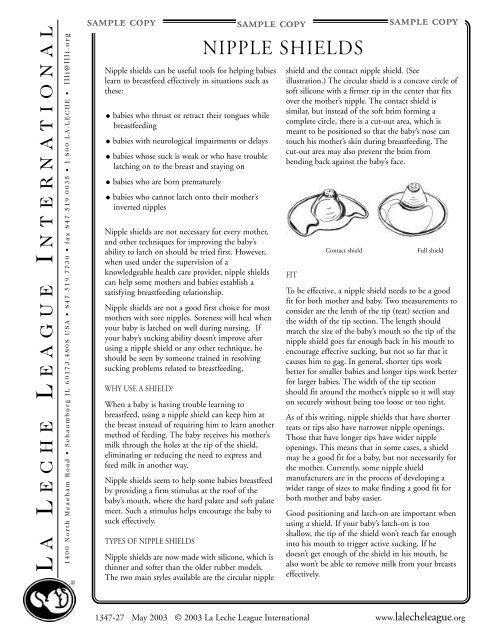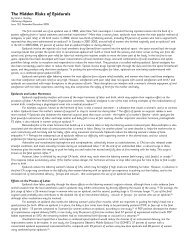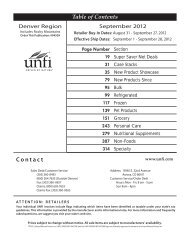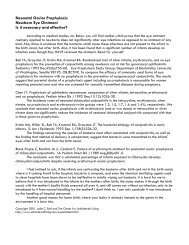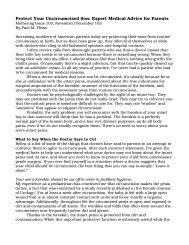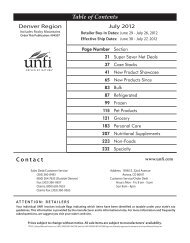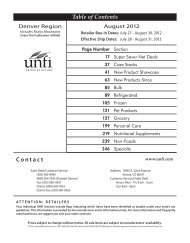Nipple shields
Nipple shields
Nipple shields
Create successful ePaper yourself
Turn your PDF publications into a flip-book with our unique Google optimized e-Paper software.
L A L ECHE L EAGUE I NTERNATIONAL<br />
1400 North Meacham Road • Schaumburg IL 60173.4808 USA • 847.519.7730 • fax 847.519.0035 • 1.800.LA.LECHE • llli@llli.org<br />
sample copy sample copy sample copy<br />
<strong>Nipple</strong> <strong>shields</strong> can be useful tools for helping babies<br />
learn to breastfeed effectively in situations such as<br />
these:<br />
babies who thrust or retract their tongues while<br />
breastfeeding<br />
babies with neurological impairments or delays<br />
babies whose suck is weak or who have trouble<br />
latching on to the breast and staying on<br />
babies who are born prematurely<br />
babies who cannot latch onto their mother’s<br />
inverted nipples<br />
<strong>Nipple</strong> <strong>shields</strong> are not necessary for every mother,<br />
and other techniques for improving the baby’s<br />
ability to latch on should be tried first. However,<br />
when used under the supervision of a<br />
knowledgeable health care provider, nipple <strong>shields</strong><br />
can help some mothers and babies establish a<br />
satisfying breastfeeding relationship.<br />
<strong>Nipple</strong> <strong>shields</strong> are not a good first choice for most<br />
mothers with sore nipples. Soreness will heal when<br />
your baby is latched on well during nursing. If<br />
your baby’s sucking ability doesn’t improve after<br />
using a nipple shield or any other technique, he<br />
should be seen by someone trained in resolving<br />
sucking problems related to breastfeeding.<br />
Why use a shield?<br />
When a baby is having trouble learning to<br />
breastfeed, using a nipple shield can keep him at<br />
the breast instead of requiring him to learn another<br />
method of feeding. The baby receives his mother’s<br />
milk through the holes at the tip of the shield,<br />
eliminating or reducing the need to express and<br />
feed milk in another way.<br />
<strong>Nipple</strong> <strong>shields</strong> seem to help some babies breastfeed<br />
by providing a firm stimulus at the roof of the<br />
baby’s mouth, where the hard palate and soft palate<br />
meet. Such a stimulus helps encourage the baby to<br />
suck effectively.<br />
Types of nipple <strong>shields</strong><br />
<strong>Nipple</strong> <strong>shields</strong> are now made with silicone, which is<br />
thinner and softer than the older rubber models.<br />
The two main styles available are the circular nipple<br />
<strong>Nipple</strong> Shields<br />
shield and the contact nipple shield. (See<br />
illustration.) The circular shield is a concave circle of<br />
soft silicone with a firmer tip in the center that fits<br />
over the mother’s nipple. The contact shield is<br />
similar, but instead of the soft brim forming a<br />
complete circle, there is a cut-out area, which is<br />
meant to be positioned so that the baby’s nose can<br />
touch his mother’s skin during breastfeeding. The<br />
cut-out area may also prevent the brim from<br />
bending back against the baby’s face.<br />
Fit<br />
Contact shield<br />
Full shield<br />
To be effective, a nipple shield needs to be a good<br />
fit for both mother and baby. Two measurements to<br />
consider are the lenth of the tip (teat) section and<br />
the width of the tip section. The length should<br />
match the size of the baby’s mouth so the tip of the<br />
nipple shield goes far enough back in his mouth to<br />
encourage effective sucking, but not so far that it<br />
causes him to gag. In general, shorter tips work<br />
better for smaller babies and longer tips work better<br />
for larger babies. The width of the tip section<br />
should fit around the mother’s nipple so it will stay<br />
on securely without being too loose or too tight.<br />
As of this writing, nipple <strong>shields</strong> that have shorter<br />
teats or tips also have narrower nipple openings.<br />
Those that have longer tips have wider nipple<br />
openings. This means that in some cases, a shield<br />
may be a good fit for a baby, but not necessarily for<br />
the mother. Currently, some nipple shield<br />
manufacturers are in the process of developing a<br />
wider range of sizes to make finding a good fit for<br />
both mother and baby easier.<br />
Good positioning and latch-on are important when<br />
using a shield. If your baby’s latch-on is too<br />
shallow, the tip of the shield won’t reach far enough<br />
into his mouth to trigger active sucking. If he<br />
doesn’t get enough of the shield in his mouth, he<br />
also won’t be able to remove milk from your breasts<br />
effectively.<br />
1347-27 May 2003 © 2003 La Leche League International www.lalecheleague.org
sample copy sample copy sample copy<br />
Applying the shield<br />
There are differences of opinion about how best to apply a<br />
nipple shield. Here are a few suggestions.<br />
Place the shield over your breast, with your nipple<br />
centered inside the tip. Press your fingers along the edge<br />
of the brim to keep it in place.<br />
Place the shield on your breast with the soft brim turned<br />
out away from the breast, then smooth the brim onto<br />
your breast.<br />
Turn the tip halfway inside out and place it over your<br />
nipple. Then slowly ease the shield fully right side out<br />
and onto the nipple.<br />
Dip the shield in hot or warm water before putting it on<br />
or apply a small bit of Lansinoh Brand Lanolin for<br />
Breastfeeding Mothers ® to help it cling to your skin.<br />
Milk supply concerns<br />
When use of a nipple shield starts, mothers should<br />
monitor their supply of milk and their babies’ weight gain<br />
carefully. In the first few days, it is helpful to pump after<br />
feedings. Milk gathered in this way can be used as a<br />
supplement if one is needed. Mothers of babies who are<br />
premature or have neurological disorders may have been<br />
pumping before starting to use a nipple shield.<br />
After nursing, look for milk in the tip of the shield and<br />
check for a decrease in breast firmness. Your baby’s health<br />
care provider may suggest periodic weight checks to make<br />
sure your baby is getting enough milk. You can also<br />
monitor the adequacy of your milk supply by keeping<br />
track of the number of your baby’s wet and dirty diapers.<br />
If your baby needs a supplement, you can use a nursing<br />
supplementer along with a nipple shield. A supplementer<br />
encourages some babies to suckle well, because swallowing<br />
helps trigger more effective suckling. Pay close attention to<br />
your baby’s position at the breast as you begin using a<br />
supplementer to be sure he is sucking actively and taking<br />
enough of your breast into his mouth. Some babies learn<br />
to suck the supplement from the supplementer without<br />
breastfeeding effectively.<br />
Weaning from a shield<br />
diapers he has to be sure he is getting as much milk<br />
without the shield as he was with the shield.<br />
You may encourage your baby to breastfeed without the<br />
nipple shield by providing more skin-to-skin contact in<br />
between feedings. At feeding times, let him nurse with the<br />
shield until his initial hunger is eased and then try to<br />
remove the shield and offer your bare breast. Use your<br />
knowledge of your baby’s likes and dislikes to discover a<br />
way that works for you. Be patient. Babies stop using<br />
nipple <strong>shields</strong> when they don’t need them any more.<br />
The decisions you make about using a nipple shield will be<br />
as individual as you are. If your baby is having trouble<br />
learning to breastfeed, you will especially appreciate the<br />
company of other mothers interested in breastfeeding. You<br />
can meet other breastfeeding mothers at local La Leche<br />
League meetings. To find a La Leche League Group near<br />
you, look in your local phone book, call LLLI at 800-LA<br />
LECHE or 847-519-7730, or check on our Web site at<br />
www.lalecheleague.org/WebIndex.html<br />
Resources<br />
Bodley, V. and Powers, D. Long-term nipple shield use–A positive perspective.<br />
J Hum Lact 1996; 12:301-04.<br />
Brigham, M. Mothers’ reports of the outcome of nipple shield use. J Hum<br />
Lact 1996; 12:291-97.<br />
Clum, D. and Primomo, J. Use of a silicone nipple shield with premature<br />
infants. J Hum Lact 1996; 12(4):287-90.<br />
Elliot, C. Using a silicone nipple shield to assist a baby to latch. J Hum Lact<br />
1996; 12:309-13.<br />
Meier, P. <strong>Nipple</strong> <strong>shields</strong> for perterm infants: effect of milk transfer and<br />
duration of breastfeeding. J Hum Lact 2000; 16(2): 106-14.<br />
Mohrbacher, N. and Stock, J. The Breastfeeding Answer Book.<br />
Schaumburg, IL: LLLI, 2003.<br />
Sealy, C. N. Rethinking the use of nipple <strong>shields</strong>. J Hum Lact 1996; 12:299-<br />
300.<br />
The Womanly Art of Breastfeeding. Schaumburg, IL: LLLI, 1997.<br />
Wilson-Clay, B. Clinical use of silicone nipple <strong>shields</strong>. J Hum Lact 1996;<br />
12(4):279-85.<br />
Woodworth, M. and Frank, E. Transitioning to the breast at six weeks: use of<br />
a nipple shield. J Hum Lact 1996; 12:305-07.<br />
For breastfeeding support, to order our publications, or to<br />
find an LLL Leader near you, use our Web site at:<br />
www.lalecheleague.org<br />
Or phone: 800 LA LECHE (9-5 Central Time)<br />
847-519-7730 (24-hour messages)<br />
Follow your baby’s cues in discontinuing use of the nipple<br />
shield. A baby may use a nipple shield for a few days or a<br />
few months. Premature babies who use nipple <strong>shields</strong> are<br />
often observed to stop needing to use them around the<br />
time of their original due dates.<br />
During the time your baby is weaning from a nipple<br />
shield, keep a close watch on how many wet and dirty<br />
© 2003 La Leche League International


